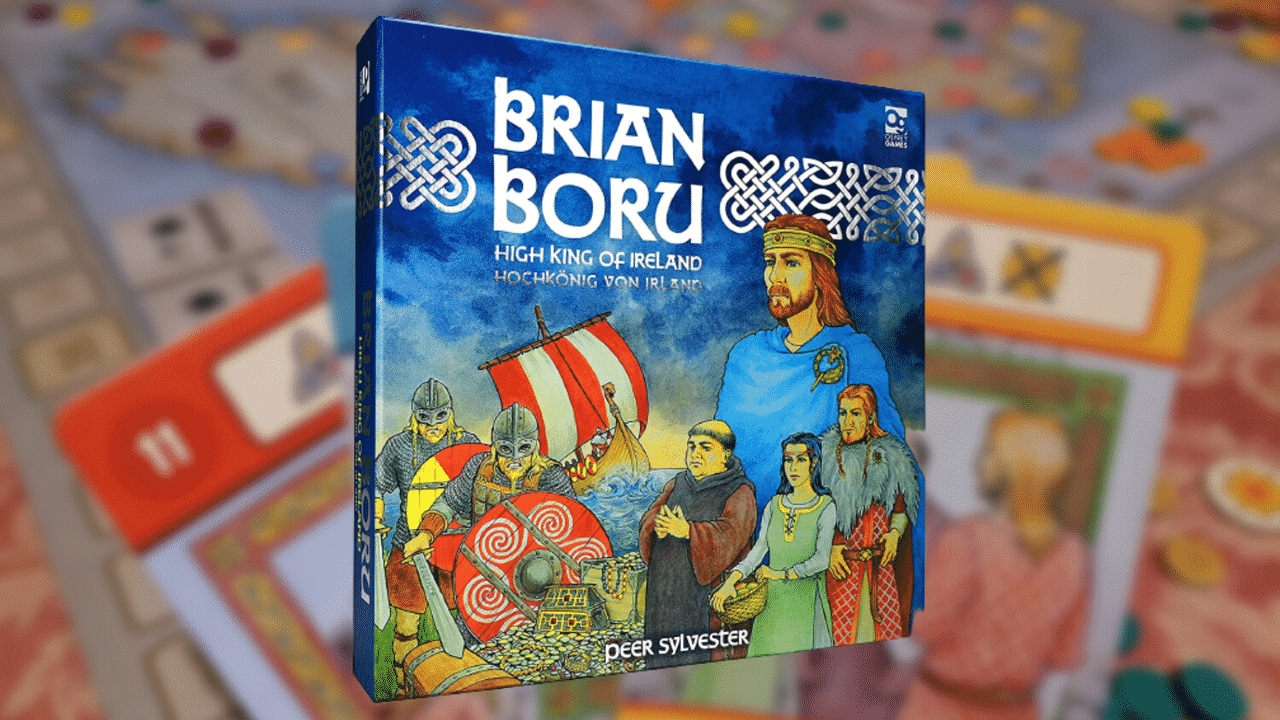[ad_1]
Trick-taking is an integral part of many card games. Most people are familiar with it. The leader player begins by playing a card. The highest card from that suit wins the hand. Yet it’s not used that widely in hobby games, perhaps because it’s so commonplace, despite the fact it would make games easier to learn.
Enter Brian Boru: The High King of Ireland. This game is named after a well-known king from medieval Ireland.Amazon has it.). This comfortable trick-taking idea is used, but it has two distinct components. It removes a lot of randomness by having players draw cards rather than a random deal. The second is that the results of tricks determine which towns you control on an Irish map. These innovations make the simple trick more interesting and innovative.
What’s In The Box
Brian Boru is packaged in a large, shallow box that can hold a large board and some tracks. It’s a beautiful thing, painted in gentle tones to suggest an ancient chart and decorated with knotwork and Celtic fonts.
High quality artwork is evident throughout the game. The same effect is evident on the cards. These large, tarot-sized cards depict people, places, or items that are relevant to the period in classic knotwork borders.
Both board and cards are thick with icons, which fit the style of the game but are a little hard to decipher until you’re familiar with the rules. You can complete your components with some punchboards of tokens or a set wooden discs in five different colors.
Rules and How to Play
Brian Boru’s core is card-drafting and trick-taking. This is simple to grasp. Each player receives a hand of cards. They choose two cards and then pass the rest to the next player. Repeat this until everyone has a complete hand. It’s a clever way to start out, giving a seed of randomness and variety but still offering interesting choices for the players to make.
There are two or three types of icons for cards. The highest icons are the actions you take when you win a card trick. They always include taking over a whole town. The lower sets gain you resources, and you can choose one if you play that card into a trick and don’t win. This creates interesting twists when deciding which loser card to throw into your trick.
“
Each card has four colors, and each one offers compensation actions that connect to a larger aspect of the game. Red lets you fight the Viking incursions in Ireland. This is possible through the abstract concept that Viking tokens can be taken. As you work to ensure your noble family is secure, yellow will help you get on the right track to marriage. Blue allows you to influence the church and gain monasteries that will increase your on-board influence. You can also gain money with all the cards. The wild card, white, is your only choice.
As you attempt to win tricks like a serpentine Celtic ouroboros gnawing its tail, this creates a complex series of decisions that you need to make. You can win the most points by placing towns on the maps. Points are awarded for both having more towns in an area or having as many towns as possible.
Fighting Vikings can help you score well. The added incentive is that the player who has the fewest Viking tokens is at greater risk of having their town overthrown by raiders. They’ll be spared, however, if all the invading tokens for the round are defeated. Sometimes it’s worth holding off on defeating Vikings in order to ensure someone gets pillaged. This can cause real terror towards the end of each round, as you wait to see if anyone is up for the chop.
Neglecting other areas can be dangerous. It is not always possible to place towns in a winning area without spending money. You can often place a town from a losing trick too if you’ve got the cash to pay more and connect it to an existing town you control via a road. You can win the game by moving up the marriage track. You can gain monasteries from your church to improve your area control, which can be a huge win.
Each round, the person with the greatest influence in the church wins all the tricks. This is a fascinating double-edged weapon. The trick starts by the lead player choosing the town they wish to compete for. This lets them concentrate on the areas they want to win while keeping others away from the places they already control. But by playing the first card they’re at higher risk of being beaten by the following plays.
Trying to track what’s gone and what you’re likely to win, while also factoring in the town you’re playing for, your cash, Vikings, and position on the church and marriage can feel like being at the controls of an airliner. It’s all laid out clearly before you, but there’s so much to consider that it’s horrifically easy to make major errors in the heat of the moment.
Once you’re behind, it can be difficult to catch up. Brian Boru gives you full control over your decisions, but also leaves you vulnerable to the unforeseeable. While there’s little randomness, you can’t plan for whether other players will over or under-bid you on a trick, as it will depend on what resources they need and risks they take. You can put in a lot of effort to get to the top, but then you might be thrown off by an unexpected player. This is frustrating.
Once the dynamic trick-taking is over, there’s a clean up phase where you see who’s won each aspect of the game that turn and dole out points accordingly. This is tiresome and fiddly, and your first couple of games won’t be helped by some unclear rules. It quickly becomes more intuitive and quicker.
Where to Buy
[ad_2]
Source link
